Sociolinguistics
语言学复习资料

语言学复习资料下定义1.(P3)Sociolinguistics(社会语言学): The studies of all the social aspects of language and its relation with society is called sociolinguistics.2.(P7)Language(语言): Language is a system of arbitrary vocal symbols used for human communication.3.(P8)Arbitrariness(任意性): This means that there is no logical connection between meanings and sounds.4.(P2)Phonetics(语音学):Phonetic refers to the study of sounds used in linguistic communication.5.(P16)Voicing(浊音化): Vibration of the vocal cords results in a quality of speech sounds.6.(P26)Assimilation rule(同化规则): The assimilation rule assimilates one sound to another by “copying” a feature of a sequential phoneme, thus making the two phones similar.7.(P29)Intonation(语调): When pitch, stress and sound length are tied to the sentence rather than the word in isolation, they are collectively known as intonation.8.(P42)Syntax(句法): Syntax is a branch of linguistics that studies the rules that govern the formation of sentences.9.(P42)Category(范畴): Category refers to a group of linguistic items which fulfill the same or similar functions in a particular language such as a sentence, a noun phrase or a verb.10.(P48)Complementizers(补语化成分):Words which introduce the sentence complement are termed complementizers.11.(P53)Head movement(中心语移动): The movement of a word from the head position in one phrase into the head positionin another is known as head movement.12.(P64-65)Linguistic context(语言语境): The linguistic context is concerned with the probability of a word’s co-occurrence or collocation with another word.13.(P66)Reference(所指): Reference means what a linguistic form refers to in the real, physical world.14.(P70)Relational opposites(关系反义词): Pairs of words that exhibit the reversal of a relationship between the two items are called relational opposites.15.(P74)Argument(论元): An argument is a logical participant in a predication, largely identical with a nominal element in a sentence.16.(P77)Pragmatics(语用学): Pragmatics is the study of how speakers of a language use sentences to effect successful communication.17.(P81)Constatives(表述句): Constatives are statements that either state or describe, and are thus verifiable.填空题第一章1. (P3) If a linguistic aims to describe and analyze the language people actually use, it is said to be descriptive(描写性的). If the linguistic study aims to lay down rules for “correct and standard” behavior in using language, it is said to be prescriptive(规定性的).2.(P4) The description of a language at some point of time in history is a synchronic(共时的)study; the description of a language as it changes through time isa diachronic(历时的)study.3.(P4) Langue(语言)refers to the abstract linguistic system shared by all the members of a speech community, and parole(言语)refers to the realization of language in actual use4. (P5) Chomsky defines competence(语言能力)as the ideal user’s knowledge of the rules of his language, and performance (语言表现)the actual realization of his knowledge in linguistic communication.第二章5.(P17)As some speech sounds produced differ only in some detailed aspects, the IPA provides its users with another set of symbols called diacritics(发音符号/辨音符)6. (P23) A phoneme(音素)is a phonological unit, it is a unit that is of distinctive value, it is an abstract value.7. (P24) It can be easily observed that phonetically similar sounds might be related in two ways. If they are two distinctive phonemes,they are said to form a phonemic contrast(音素对照),e.g. /p/ and /b/ in [pit] and [bit].8. (P24)When two different forms are identical in every way except for one sound segment which occur the same position in the strings, the two sound combinations are said to from a minimal pair(最小配对).e.g pill and bill, pill and till are a minimal pair.9.(P25) Rules that govern the combination of sounds in a particular language, the rules are called sequential rules(序列规则).10.(P27) The phonemic features that occur above the level of the segments are called suprasegmental feature(超音段特征).第三章11.(P33)Morpheme(词素): the smallest unit of language that carries information about meaning or function.A morpheme which can be a word by itself is called a free morpheme(自由词素). Whereas a morpheme that must beattached to another one is called bound morpheme(粘着词素).12.(P33) The variant forms of a morpheme are called its allomorphs(词素变体).第四章13. (P44) Syntactic units that are built around a certain word category are called phrases(短语), the category of which is determined by the word category around which the phrase is built.14. (P45)Phrases that are formed of more than one word usually contain the following elements: head(中心语), specifier(标志语)and complement(补语).15. (P48)The information about a word’s complement is included in the head andtermed subcategorization(次范畴化).16. (P52) Transformation(转换)is a special type of rule that can move an element from one position to another.第五章17. (P67-68)Synonymy:近义关系的分类:1) Dialectal synonyms(方言同义词)-- synonyms used in different regional dialects.(来自不同地域的人使用同一种语言产生的不同)2) Stylistic synonyms(文体同义词) -- synonyms differing in style3) Synonyms that differ in their emotive or evaluative(评价) meaning4) Collocational synonyms(搭配同义)5) Semantically different synonyms(不考)18.(P69) When two words are identical in sound, they are homophones(同音不同形不同义). When two words are identical in spelling, they are homographs(同形不同音不同义). When twowords are identical in both sound and spelling, they are complete homonyms(同形同音不同义).19. (P70) Antonymy:反义关系的分类1) Gradable antonyms(可分等级的反义词)2) Complementary antonyms(互补反义词)3) Relational opposites(关系反义词)20.(P72) Componential analysis(成分分析)is a way proposed by the structural semanticists to analyze word meaning. The approach is based upon the belief that the meaning of a word can be dissected into meaning components, called semantic features.第六章21. (P81)Three Speech Acts:三种言语行为According to Austin new model, a speaker might be performing three acts simultaneously when speaking:locutionary act(言内行为), illocutionary act(言外行为), and perlocutionary act(言后行为).22.(P90)Pragmatic failure(语用失误) occurs when the speaker fails to use language effectively to achieve a specific communicative purpose, or when the hearer fails to recognize the intention or the illocutionary(言外之意) force of the speaker’s utterance in the context of c ommunication.第八章23.(P111) Speech variety(言语变体), or language variety, refers to any distinguishable form of speech used by a speaker or a group of speakers.24. (P117) Halliday further distinguishes three social variables(语域三变量)that determine the register: field of discourse(语场), tenor of discourse(语旨), and mode of discourse(语式).25. (P122) The term diglossia(双言制度) refers to a sociolinguistic situation similar to bilingualism where two varieties of a language exist side by side throughout the community, with each having a definite role to play.上一页下一页。
社会语言学简介
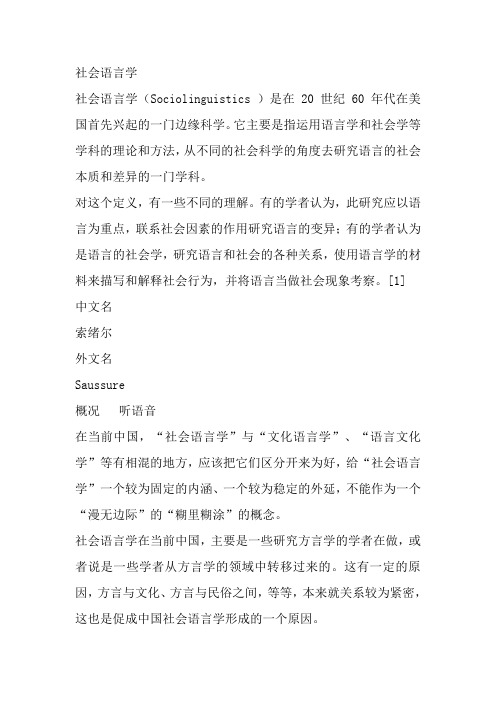
社会语言学社会语言学(Sociolinguistics )是在 20 世纪 60 年代在美国首先兴起的一门边缘科学。
它主要是指运用语言学和社会学等学科的理论和方法,从不同的社会科学的角度去研究语言的社会本质和差异的一门学科。
对这个定义,有一些不同的理解。
有的学者认为,此研究应以语言为重点,联系社会因素的作用研究语言的变异;有的学者认为是语言的社会学,研究语言和社会的各种关系,使用语言学的材料来描写和解释社会行为,并将语言当做社会现象考察。
[1]中文名索绪尔外文名Saussure概况听语音在当前中国,“社会语言学”与“文化语言学”、“语言文化学”等有相混的地方,应该把它们区分开来为好,给“社会语言学”一个较为固定的内涵、一个较为稳定的外延,不能作为一个“漫无边际”的“糊里糊涂”的概念。
社会语言学在当前中国,主要是一些研究方言学的学者在做,或者说是一些学者从方言学的领域中转移过来的。
这有一定的原因,方言与文化、方言与民俗之间,等等,本来就关系较为紧密,这也是促成中国社会语言学形成的一个原因。
社会语言学将从以下两个领域进行探索:第一,是社会生活的变化将引起语言(诸因素)的变化,其中包括社会语境的变化对语言要素的影响。
第二,从语言(诸因素)的变化探究社会(诸因素)的变化。
在第一个领域中,社会是第一性,社会有了变化,才引起语言的变化。
在第二个领域中社会仍是第一性,但未会有像语言相对论者所认为,有什么模式的语言就会产生什么样的社会模式或者社会文化。
社会语言学的任务是在于描述“语言和社会结构的共变”。
“共变”是现代语言学常用的新术语。
该命题说的“共变”是现代语言学常用的新术语。
该命题说的“共变”似乎指语言是一个变数。
这两个变数互相影响,互相作用,互相制约,互相接触而引起的互相变化。
[2]代表人物听语音索绪尔索绪尔(Saussure,1857-1913)首先提出社会语言学的研究方向。
他认为Language分为两个方面:一是语言(Langue)即平时人们研究的语言系统或是总结语言的使用,例如语法,句法,词法等;另一个方面便是言语(Parole),即社会语言学,语言的当代的使用偏好,与当代社会相关联的研究方向。
英语教育中的语言学理论
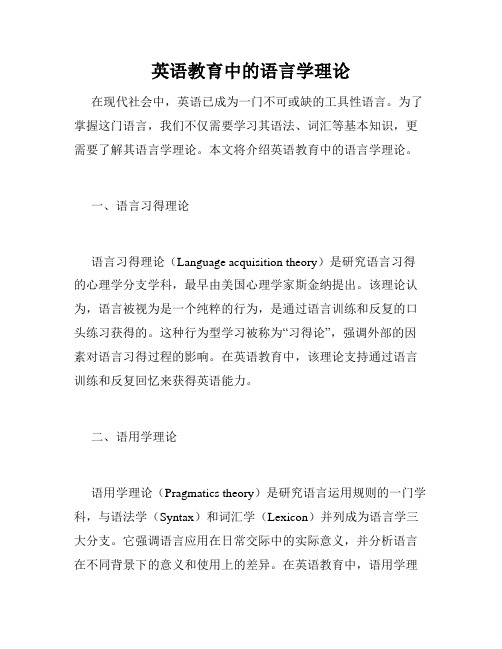
英语教育中的语言学理论在现代社会中,英语已成为一门不可或缺的工具性语言。
为了掌握这门语言,我们不仅需要学习其语法、词汇等基本知识,更需要了解其语言学理论。
本文将介绍英语教育中的语言学理论。
一、语言习得理论语言习得理论(Language acquisition theory)是研究语言习得的心理学分支学科,最早由美国心理学家斯金纳提出。
该理论认为,语言被视为是一个纯粹的行为,是通过语言训练和反复的口头练习获得的。
这种行为型学习被称为“习得论”,强调外部的因素对语言习得过程的影响。
在英语教育中,该理论支持通过语言训练和反复回忆来获得英语能力。
二、语用学理论语用学理论(Pragmatics theory)是研究语言运用规则的一门学科,与语法学(Syntax)和词汇学(Lexicon)并列成为语言学三大分支。
它强调语言应用在日常交际中的实际意义,并分析语言在不同背景下的意义和使用上的差异。
在英语教育中,语用学理论为学生了解英语在不同场合下的使用和语气、联想等方面提供了重要的指导。
三、认知语言学理论认知语言学理论(Cognitive Linguistics)是一种新兴的语言学派别,它探讨语言与思维之间的关系,研究语言知识的认知和构建方式。
该理论认为,语言的意义是由认知语言处理机制产生的,语言的规律来自于认知建构活动。
在英语教育中,认知语言学理论强调学习者将语言的概念与自己的认知结构进行联系,从而更好地理解和掌握语言。
四、社会语言学理论社会语言学理论(Sociolinguistics)分析语言在社会上的使用和使用者的社会环境的影响。
社会语言学理论强调文化和社会因素对语言使用的影响,并研究它们如何影响书面和口头语言的发展。
在英语教育中,社会语言学理论可以帮助学生了解不同文化背景和社会环境对语言的影响,更加深入地了解和运用语言。
总之,语言学理论可以为我们更好地理解和掌握英语提供帮助。
作为英语学习者,我们应该不断更新自己对语言学理论的知识,并将其运用到实际学习当中。
sociolinguistics
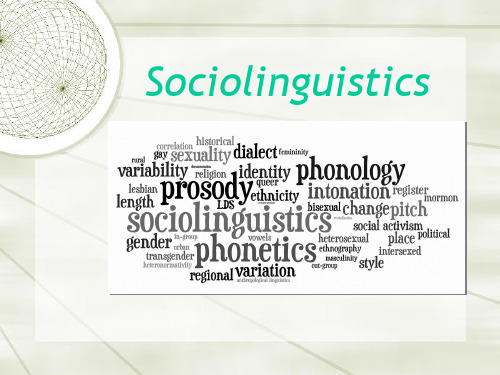
3.2 The Study Scopes of Sociolinguistics
社会语言学的研究范围:一般而言,包括以下几个方面: 1)一个国家或地区的语言状况如双言制(diglossia) 、双语、多语或多方言状况; 2)各种语言变体包括地域方言和社会方言(social dialect或sociolect)、标准语和土语(vernacular) 、正式语体(formal style)和非正式语体(informal style)等构造特点及其社会功能; 3)交谈情景与选择语码之间的关系以及语码选择与人 际关系的相互作用; 4)社会以及不同的集团对各种语言或语言变体的评价 和态度以及由此产生的社会效应; 5)由于社会的、文化的、经济的、政治的种种原因以 及语言接触所引起的语言变化的方式和规律,等等。
empirical investigation.
It is related to methodology and contents of social sciences.
2. DEVELOPMENT AND MAIN REPRESENTATIVES
ORIGINS: Saussure’s & Chomsky’s concepts PROMINENT FIGURES: William Labov & Peter Trudgill
(3). It also studies the influence of the essence and differentiations of society on language (e.g. How to distinguish a person‟s status in his social class by groups, religion, gender, educational level, age, ethnic origin, etc. which he belongs to.) On the whole, sociolinguistics, drawing upon the theories and methods of different aspects of social sciences( such as sociology, anthropology, ethnography, psychology, geography, history, etc.), studies and researches language, and its social essence and differentiations, as well as its social factors.
sociolinguistics语言学定义
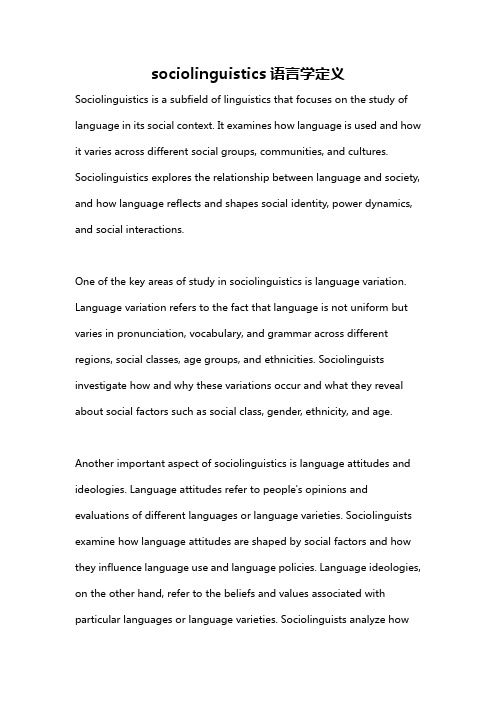
sociolinguistics语言学定义Sociolinguistics is a subfield of linguistics that focuses on the study of language in its social context. It examines how language is used and how it varies across different social groups, communities, and cultures. Sociolinguistics explores the relationship between language and society, and how language reflects and shapes social identity, power dynamics, and social interactions.One of the key areas of study in sociolinguistics is language variation. Language variation refers to the fact that language is not uniform but varies in pronunciation, vocabulary, and grammar across different regions, social classes, age groups, and ethnicities. Sociolinguists investigate how and why these variations occur and what they reveal about social factors such as social class, gender, ethnicity, and age.Another important aspect of sociolinguistics is language attitudes and ideologies. Language attitudes refer to people's opinions and evaluations of different languages or language varieties. Sociolinguists examine how language attitudes are shaped by social factors and how they influence language use and language policies. Language ideologies, on the other hand, refer to the beliefs and values associated with particular languages or language varieties. Sociolinguists analyze howlanguage ideologies influence language choices, language maintenance or shift, and language planning.Sociolinguistics also explores language and identity. Language is a fundamental aspect of individual and group identity, and sociolinguists investigate how language use and language choices contribute to the construction and negotiation of social identities. Language can be a marker of social class, ethnicity, gender, and other social categories, and sociolinguists examine how language is used to express and negotiate these identities.Power and language is another important area of study in sociolinguistics. Language is not only a means of communication but also a tool of power and social control. Sociolinguists investigate how language is used to assert dominance, maintain social hierarchies, and reproduce inequalities. They examine how language choices and language policies can reflect and perpetuate power imbalances and social inequalities.Sociolinguistics also examines language change and language contact. Language is constantly evolving, and sociolinguists study how and why languages change over time. They investigate the social factors thatdrive language change, such as contact with other languages, migration, and social mobility. Sociolinguists also analyze language contact situations, where different languages come into contact and influence each other, leading to the emergence of new linguistic varieties.In addition to these main areas of study, sociolinguistics also explores language and education, language planning and policy, language and globalization, and language and technology. Sociolinguists investigate how language is taught and learned in educational settings, how language policies are formulated and implemented, how language is affected by globalization processes, and how technology impacts language use and communication.Overall, sociolinguistics provides valuable insights into the complex relationship between language and society. It helps us understand how language is used, how it varies, and how it reflects and shapes social identities, power dynamics, and social interactions. By studying sociolinguistics, we can gain a deeper understanding of the role of language in our everyday lives and in the broader social context.。
社会语言学总结
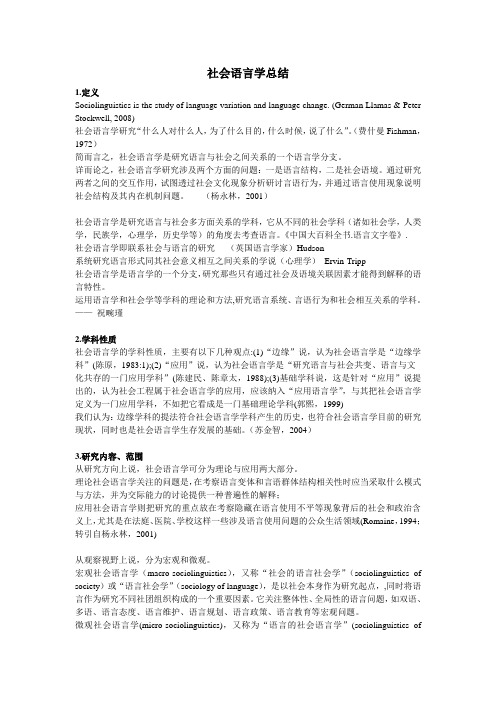
社会语言学总结1.定义Sociolinguistics is the study of language variation and language change. (German Llamas & Peter Stockwell, 2008)社会语言学研究“什么人对什么人,为了什么目的,什么时候,说了什么”。
(费什曼Fishman,1972)简而言之,社会语言学是研究语言与社会之间关系的一个语言学分支。
详而论之,社会语言学研究涉及两个方面的问题:一是语言结构,二是社会语境。
通过研究两者之间的交互作用,试图透过社会文化现象分析研讨言语行为,并通过语言使用现象说明社会结构及其内在机制问题。
(杨永林,2001)社会语言学是研究语言与社会多方面关系的学科,它从不同的社会学科(诸如社会学,人类学,民族学,心理学,历史学等)的角度去考查语言。
《中国大百科全书.语言文字卷》.社会语言学即联系社会与语言的研究----(英国语言学家)Hudson系统研究语言形式同其社会意义相互之间关系的学说(心理学)Ervin-Tripp社会语言学是语言学的一个分支,研究那些只有通过社会及语境关联因素才能得到解释的语言特性。
运用语言学和社会学等学科的理论和方法,研究语言系统、言语行为和社会相互关系的学科。
——祝畹瑾2.学科性质社会语言学的学科性质,主要有以下几种观点:(1)“边缘”说,认为社会语言学是“边缘学科”(陈原,1983:1);(2)“应用”说,认为社会语言学是“研究语言与社会共变、语言与文化共存的一门应用学科”(陈建民、陈章太,1988);(3)基础学科说,这是针对“应用”说提出的,认为社会工程属于社会语言学的应用,应该纳入“应用语言学”,与其把社会语言学定义为一门应用学科,不如把它看成是一门基础理论学科(郭熙,1999)我们认为:边缘学科的提法符合社会语言学学科产生的历史,也符合社会语言学目前的研究现状,同时也是社会语言学生存发展的基础。
Sociolinguistics
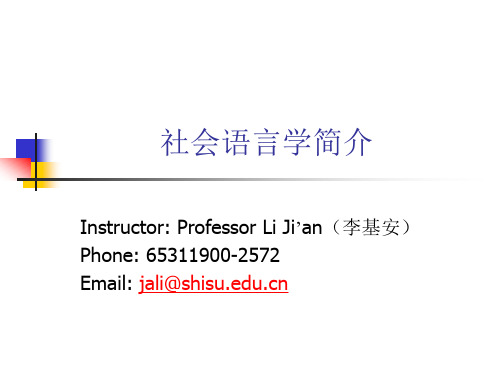
引言
社会语言学是一门年轻的学科,从确立 至今只有 40年左右的历史,但却因其独 特的学科性质和极强的发展能力而备受 关注。 社会语言学的确立以1964年在美国召开 的第9届国际语言学大会为标志。
历史背景
考察语言问题需结合社会因素的思想在 中西学术史中早已有之。 但直到18、19世纪、语言的社会性质才 真正引起人们的重视。有关语言和社会 关系的论述开始出现在一些著名学者的 文章、著作中。
主要流派
社会方言学(social dialectology) 语言社会学(sociology of language) 交际民族志学(ethnopology of communication) 语言社会心理学(social psychology of language) 互动社会语言学(interactional sociolinguistics)
而且成为许多大学语言学系的专业课程, 得到了学术界的普遍承认。
历史背景
就连当初把社会语言学研究比喻为采集蝴蝶标 本的工作,认为其重要性无法同理论语言学相 提并论的乔姆斯基,最后也改变了看法,声称 从不怀疑社会语言学研究在语言科学中的合法 地位。 当代社会语言学的应用研究在法律、广告、诊 断、教育等领域内广泛开展,已经成为社会文 化的有机组成部分之一,引起了越来越多的关 注。
主要流派
互动社会语言学(interactional sociolinguistics)
曾被译为“交际社会语言学”或“相互交往社 会语言学” 会话过程绝不是一个简单的罗列词语的过程。 研究语言和非语言知识在会话过程中的作用以 及说话人的社会文化背景如何跟这些知识相互 影响。
语言学知识

一、定义:什么是语言学?Linguistics is generally defined as the scientific study of language.二、语言学研究的核心(下面的术语要尽量全都认识,不然做题时可能看不懂选项)1、Phonetics 语音学2、Phonology 音位学3、Morphology 形态学4、Syntax 句法学5、Semantics 语义学6、Pragmatics 语用学三、语言(Langue)和言语(Parole)这个考过的。
Parole这个概念是F. de Saussure(索绪尔)提出的。
Langue指语言系统的整体,“所有(语言使用)个体头脑中存储的词语-----形象之总和”,这个整体相对较为稳定;Parole指某个个体在实际语言使用环境中说出的具体话语,它是随时间和地点变化的一个动态的实体。
四、语言的功能Functions of Language(这个也考过的。
考过the informative function,就是高速公路指示牌的那道题)1、The instrumental function2、The regulatory function3、The heuristic function4、The interactional function5、The personal function6、The imaginative function7、The informative function五、语言的普遍特征Design Features这个也考过的,这五个特征由美国语言学家Charles Hockett提出。
弱弱地说一句:如果真的在临时抱佛脚,那就不要管这五个术语的具体含义了,只要能强行记下来应付考试就是了。
>_<1、Arbitrariness 任意性2、Productivity 多产性3、Duality 双层结构4、Displacement 移位性5、Cultural Transmission 文化传播性六、语音学和音位学(一)语音学Phonetics: the study of the phonic medium of language.1、三大分支(1)Articulatory Phonetics发音语音学(2)Auditory Phonetics 听觉语音学(3)Acoustic Phonetics 声学语音学2、辅音和元音(这个考过的,考过二者的区别)(二)音位学Phonology: aims to discover how speech sounds in a language form pattern and how these sounds are used to convey meaning in linguistic communication.1、三个术语(1)Phone音素(2)Phoneme音位(3)Allophone音位变体2、Suprasegmental Phonology超音段音位(考过的)包括Stress重音、Tone音调、Intonation语调七、形态学Morphology: refers to the study of the internal structure of words, and the rules by which words are formed.(一)两类词汇1、Closed class words封闭性词汇2、Open class words开放性词汇(二)Morpheme词素1、Free morpheme自由词素2、Bound morpheme粘着词素3、Stem词干4、Root词根(三)Word-formation构词法(四)Inflection屈折变化八、句法学Syntax: studies how words are combined to form sentences and the rules that govern the formation of sentences.九、语义学Semantics: is generally considered to be the study of meaning in language.1、Synonymy同义关系2、Polysemy一词多义3、Homophones同音异义&Homogragh同形异义&Complete homonyms同形同音异义4、Hyponymy上下义关系5、Antonymy反义关系6、Analysis of meaning语义分析(1)Componential analysis成分分析(2)Predication analysis述谓分析7、 Two-place predicate二向谓词、one-place predicate一向谓词、no-place predicate 零向谓词8、 Sense relations between sentences(1)Entailment(2)Presupposition十、语用学1、Pragmatics: the study of how speakers of a language use sentences to effect successful communication. (Or it refers to the study of natural language understanding, and specifically the study of how context influences the interpretation of meanings.)2、区分语义学和语用学的最本质因素是:是否考虑了语言使用过程中的语境。
社会语言学论文(基础)Understanding of Sociolinguistics
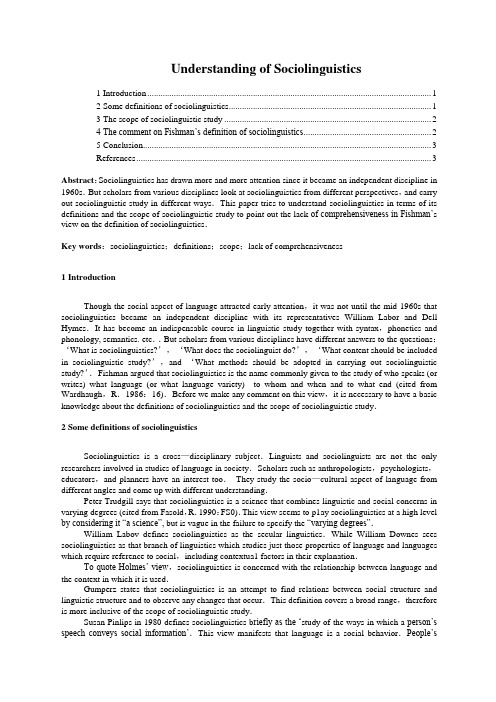
Understanding of Sociolinguistics1 Introduction (1)2 Some definitions of sociolinguistics (1)3 The scope of sociolinguistic study (2)4 The comment on Fishman’s definition of sociolinguistics (2)5 Conclusion (3)References (3)Abstract:Sociolinguistics has drawn more and more attention since it became an independent discipline in 1960s.But scholars from various disciplines look at sociolinguistics from different perspectives,and carry out sociolinguistic study in different ways.This paper tries to understand sociolinguistics in terms of its definitions and the scope of sociolinguistic study to point out the lack of comprehensiveness in Fishman’s view on the definition of sociolinguistics.Key words:sociolinguistics;definitions;scope;lack of comprehensiveness1 IntroductionThough the social aspect of language attracted early attention,it was not until the mid 1960s that sociolinguistics became an independent discipline with its representatives William Labor and Dell Hymes.It has become an indispensable course in linguistic study together with syntax,phonetics and phonology, semantics. etc..But scholars from various disciplines have different answers to the questions:‘What is sociolinguistics?’,‘What does the sociolinguist do?’,‘What content should be included in sociolinguistic study?’,and ‘What methods should be adopted in carrying out sociolinguistic study?’.Fishman argued that sociolinguistics is the name commonly given to the study of who speaks (or writes) what language (or what language variety) to whom and when and to what end (cited from Wardhaugh,R.1986:16).Before we make any comment on this view,it is necessary to have a basic knowledge about the definitions of sociolinguistics and the scope of sociolinguistic study.2 Some definitions of sociolinguisticsSociolinguistics is a cross—disciplinary subject.Linguists and sociolinguists are not the only researchers involved in studies of language in society.Scholars such as anthropologists,psychologists,educators,and planners have an interest too.They study the socio—cultural aspect of language from different angles and come up with different understanding.Peter Trudgill says that sociolinguistics is a science that combines linguistic and social concerns in varying degrees (cited from Fasold,R.1990:FS0).This view seems to p1ay sociolinguistics at a high level by considering it “a science”, but is vague in the failure to specify the “varying degrees”.William Labov defines sociolinguistics as the secular linguistics.While William Downes sees sociolinguistics as that branch of linguistics which studies just those properties of language and languages which require reference to social,including contextua1 factors in their explanation.To quote Holmes’ view,sociolinguistics is concerned with the relationship between language and the context in which it is used.Gumperz states that sociolinguistics is an attempt to find relations between social structure and linguistic structure and to observe any changes that occur.This definition covers a broad range,therefore is more inclusive of the scope of sociolinguistic study.Susan Pinlips in 1980 defines sociolinguistics b riefly as the ‘study of the ways in which a person’s speech conveys social information’.This view manifests that language is a social behavior.People’sdifferent choices of linguistic forms may reflect their different social background.Wolfson expresses his view by saying that sociolinguistics is the study of the interplay of linguistic,social,and cultural factors in human communication.In Longman Dictionary of Language Teaching &Applied Linguistics, sociolinguistics is defined as the study of language in relation to social factors, that is, social class,educational level and type of education, Age, sex,ethnic origins,etc.(Richard,J.C.1992:425).It seems that there is no agreement on the exact definition of sociolinguistics,just like what Dell Hymes has claimed:“Different people may have different understanding of the term ‘sociolinguistics’.Therefore,no one has the patent for its definition.”(cited in Fasold.1990:F 12) But however different views scholars hold,they are ready to agree at least one point.That is,sociolinguistics studies the relation between language and society.Whatever sociolinguistics is,it must be oriented toward both data and theory.But still scholars will come up with different answers to the question ‘What content should be included in sociolinguistic study?’.3 The scope of sociolinguistic studyWe can generally divide sociolinguistic study into the broad sense and the narrow sense.The former is also widely called the macro-sociolinguistics,and the latter micro-sociolinguistics.To make the division clear, Wolfson compared sociolinguistic study to a sort of telescope through which language behavior may be studied in its socio-cultural context.In looking through the small end of the telescope,we view speech at the level of face-to-face interaction,and this type of study is called micro-sociolinguistics.By looking through the large end of the sociolinguistic telescope,we are able to see the workings of language contact,choice,use,maintenance,and change at the social level,a field of study called the sociology of language or macro-sociolinguistics.Hudson in 1980 made a distinction between sociolinguistics and the sociology of language in stating that the former is the study of language in relation to society while the later is the study of society in relation to language(cited in Wardhaugh,R.1986:12-13). That is to say.sociolinguistics can be studied either from the perspective of language or from that of society.Hudson further argues that the influence which society exerts on language is the major concern of sociolinguistic study.Some scholars also classify sociolinguistic study into the theoretical research model and the practical research mode1.But no matter how scholars define and understand sociolinguistics,it is generally agreed that sociolinguistic study mainly deals with social variation, language varieties,the differences of language use conventions,and the socio-cultural factors that contribute to the variation, varieties and differences.Social variation in language including the variation of region,social class, register, style,age and sex has been one of the major focuses of sociolinguistics since its formation in the early 1960.Language variety has been and still is the main concern of sociolinguistics,but the scope of sociolinguistic study may be very wide such that it can cover almost everything.Sociolinguistics is an empirical science.it must be founded on an adequate data base.This requires that when we are considering sociolinguistics,we should take the various kinds of research methods Into account.It is better to collect data through observing naturally occurring linguistic events.The ethnomethodology makes one significant contribution to the development of sociolinguistic study.4 The comment on Fishman’s definition of so ciolinguisticsFishman says that sociolinguistics is the name commonly given to the study of who speaks(or writes)what language (or what language variety)to whom and when and to what end.The American sociolinguist Nessa Wolfson shares the similar view with Fishman in generalizing the scope of sociolinguistics to be‘Who says what to whom,when and how’(cited from Hudson.1980:F14).Brief as Fishman’s definition is,it includes the major elements in sociolinguistics:“what” representsthe language or language variety.“who”, “whom”, “when”and “to what end”represent those social variables.This may be better understood by considering the four components that influence linguistic choices,namely,the participants,the setting or social context of the interaction.the topic and the function(Holmes,Janet.1997:12).Hymes’s SPEAKING theory may also be adopted to account for Fishman’s definition to some extent.In spite of its brevity and reasonableness,this definition is not comprehensive enough to inform us the nature of sociolinguistics,the relationship between it and the sociology of language or other disciplines.Neither does it cover the broad range of the scope of sociolinguistic study.It looks at sociolinguistics from the viewpoint of interpersonal interactions,and covers social variation and language variety, thus belongs to the scope of micro-sociolinguistics.To mention only the language variety does not make the whole story.It also fails to mention the research methods and the theoretical base of sociolinguistic study.Therefore,Fishman’s definition can not provide us with an overall and thorough understanding of sociolinguistics.5 ConclusionThough scholars from various disciplines have shown great interest in the socio—cultural aspect of language,different researchers define sociolinguistics differently and come up with different understanding.In fact,sociolinguistic study is characterized by a wide variety or inclusiveness of its research scope.Cf.McGregor argues that as long as we are fully aware of this point,questions like “How to define sociolinguist ics?” and “What content should be included in sociolinguistic study?” seem to be not very imperative and important(quoted in Fasold,R.1990:F12).References1, Downes, William,1998.Language and Society【M】.2nd edition.Cambridge:CUP.2, Fasold,R.1 990 The Sociolinguistics【M】.Oxford:Blackwell Publishers Ltd.3, Holmes.Janet.I 997.An Introduction to Sociolinguistics【M】.New York:Longman Ltd.4, Hudson,R.A.1 980.Sociolinguistics【M】.2-edition.Cambridge:CUP.5, Richards,C.J.and Platt,J.and Platt,H.1 992.Longman Dictionary of Language Teaching&Applied Linguistics【M】.New York:Longman Ltd.6, Salzmann,Zdenek.1993.Language.Culture.& Social An Introduction to Linguistic Anthropology 【M】.Boulder:Westview Press,Inc.7, Trask,R.L.I999.Key Concepts in Language and Linguistics【M】.London;Routledge.8, Wardhaugh.R.1986.An Introduction to Sociolinguistics:Issues of Society and Schooling 【M】.Oxford:Basil Blackwel1.9, Wardhaugh.R.1998.An Introduction to Sociolinguistics【M】.3 edition.Oxford:Blackwel1.10, Wolfson,N.1989.Perspectives.Sociolinguistics and TESOL【M】.Cambridge:Newbury.。
语言学流派
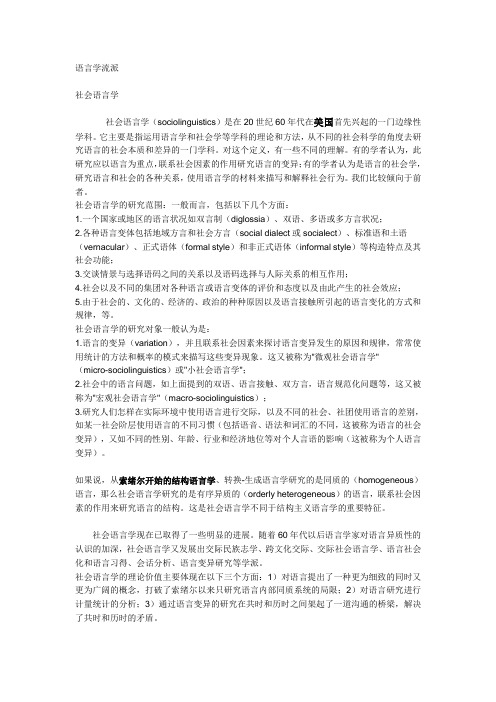
语言学流派社会语言学社会语言学(sociolinguistics)是在20世纪60年代在美国首先兴起的一门边缘性学科。
它主要是指运用语言学和社会学等学科的理论和方法,从不同的社会科学的角度去研究语言的社会本质和差异的一门学科。
对这个定义,有一些不同的理解。
有的学者认为,此研究应以语言为重点,联系社会因素的作用研究语言的变异;有的学者认为是语言的社会学,研究语言和社会的各种关系,使用语言学的材料来描写和解释社会行为。
我们比较倾向于前者。
社会语言学的研究范围:一般而言,包括以下几个方面:1.一个国家或地区的语言状况如双言制(diglossia)、双语、多语或多方言状况;2.各种语言变体包括地域方言和社会方言(social dialect或socialect)、标准语和土语(vernacular)、正式语体(formal style)和非正式语体(informal style)等构造特点及其社会功能;3.交谈情景与选择语码之间的关系以及语码选择与人际关系的相互作用;4.社会以及不同的集团对各种语言或语言变体的评价和态度以及由此产生的社会效应;5.由于社会的、文化的、经济的、政治的种种原因以及语言接触所引起的语言变化的方式和规律,等。
社会语言学的研究对象一般认为是:1.语言的变异(variation),并且联系社会因素来探讨语言变异发生的原因和规律,常常使用统计的方法和概率的模式来描写这些变异现象。
这又被称为"微观社会语言学"(micro-sociolinguistics)或"小社会语言学";2.社会中的语言问题,如上面提到的双语、语言接触、双方言,语言规范化问题等,这又被称为"宏观社会语言学"(macro-sociolinguistics);3.研究人们怎样在实际环境中使用语言进行交际,以及不同的社会、社团使用语言的差别,如某一社会阶层使用语言的不同习惯(包括语音、语法和词汇的不同,这被称为语言的社会变异),又如不同的性别、年龄、行业和经济地位等对个人言语的影响(这被称为个人语言变异)。
Sociolinguistics社会语言学
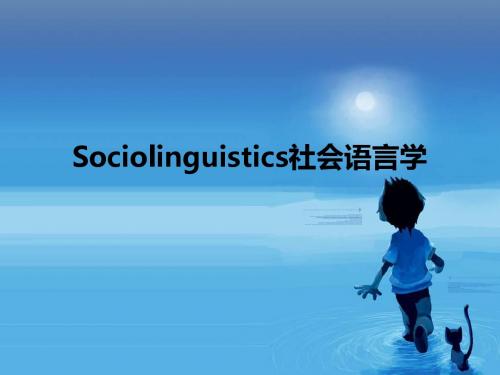
the Research Contents 研究内容
t h e characteristics of l a n g u a g e varieties
t h e characteristics of their functions
the characteristics of their speakers
它试图揭示出那些能解释和限制言语社团中语言行为和作用于语 言行为的社会规则和规范,同时,也努力去确定语言多样性对于说 话者的符号性价值。而这种由语言的多样性产生的符号性或象征性 特征,是语言功能差异的必然结果。
as these three constantly interact and change within a speech community.
社会语言学研究语言多样性的特征,他们的功能特征和说话者的 特征以及这三者在言语社团中持续的交互作用和变化。
It seeks to discover the societal rules and norms that explain and constrain language behaviour and the attitudes toward language in speech communities. It also seeks to determine the symbolic value of language varieties for their speakers.That fact that language varieties come to take on symbolic or symptomatic value,in and of themselves,is an inevitable consequence of their functional differentiation.
历史比较语言学

历史比较语言学历史比较语言学(historical comparative linguistics),语言学中一个重要的部门,它以历史比较法为基础,研究语言的亲属关系。
历史比较语言学是历史语言学的重要组成部分,它为现代语言学的建立奠定了坚实的基础,是语言学走上独立发展道路的标志。
基本简介比较语言学,又称历史比较语言学,把有关各种语言放在一起加以共时比较或把同一种语言的历史发展的各个不同阶段进行历时比较,以找出它们之间在语音、词汇、语法上的对应关系和异同的一门学科。
利用这门学科一方面可以研究相关语言之间结构上的亲缘关系,找出它们的共同母语,或者明白各种语言自身的特点对语言教学起到促进作用,另一方面,可以找出语言发展、变化的轨迹和导致语言发展、变化的原因。
十九世纪它就广泛地应用于印欧语的语言研究,取得了很大成就。
奠基人是德国语言学家格林(Grimn)、博普(Bopp)和丹麦语言学家拉斯克(Rask)。
文学起源历史比较语言学起源于18和19世纪的欧洲,研究重点是印欧语系诸语言的语音系统。
1786年英国学者威廉·琼斯在对梵语做了深入的研究之后指出,梵语同拉丁语和希腊语之间存在着非常有系统的对应关系。
例如就词首辅音而言,“三”在梵语、希腊语和拉丁语中都是t,“父亲”都是p。
这种系统的对应现象非常普遍,绝不可能归结为偶然因素。
琼斯同时认为,要解释这种现象,只有认为它们共同源自现在也许已经消亡了的某种语言。
接着,丹麦学者R.K.拉斯克、德国学者F.博普、J.格林等人在更多的语言中发现了类似的对应现象,并且根据这些系统的对应关系,推测了它们的共同起源──原始印欧语的表现形式,同时把原始印欧语同后来语言之间的关系用简洁明确的定律形式表现了出来。
发展经历在拉斯克、博普、格林等人相继对印欧语系作了大量调查研究的基础上,德国莱比锡大学的一批学者把当时历史比较语言学研究所取得的成果上升到理论的高度加以总结,正式为历史比较语言学提出系统的理论原则和方法。
社会语言学

游汝杰、邹嘉彦 指出社会语言学(Sociolinguistics)学科名称是由社会学(Sociology)和语言学(Linguistics)复合而成,内容包括两个方面,一是Social Linguistics,基本涵义是:从语言的社会属性出发,用社会学的方法研究语言,从社会的角度解释语言变体和语言演变。二是Sociology of Language,基本涵义是:从语言变体和语言演变的事实,来解释相关的社会现象及其演变和发展的过程。 从研究方向来界定社会语言学,简而言之,前者是从社会研究语言,后者是从语言研究社会。
祝畹瑾
祝畹瑾 她将研究内容细分为五个方面:(1)一个国家或地区的语言状况,和按照各种属性划分的言语共同体使用语言的状况和特征;(2)各种语言变体的构造特点及其社会功能;(3)交谈的情景与选择语码之间的关系以及语码选择与人际关系的相互作用;(4)社会以及不同的集团对各种语言变体的评价和态度以及由此产生的社会效应;(5)由于社会的、文化的、经济的政治的种种原因以及语言接触所引起的语言变化的方式和规律等。 她的界定主要是关注言语共同体、语言变体、语码转换、社会与变体的联系这几个方面。
Sociolinguistics is an umbrella term which covers a variety of different interests in language and society,including the social functions of language and the social characteristics of its users.Sociolinguistics is the studyguage varieties,the characteristics of their functions,and the characteristics of their speakers as these three constantly interact and change within a speechIseeks to discover the societal rules and norms that explain and constrain language behaviour and the behaviour toward language in speech also seeks to determine the symbolic value of language varieties for their speakers.That language varieties come to have symbolic or symptomatic value,in and of themselves,is an inevitable consequence of their functional differentiation.(Reproduction of this article without written permission is strictly prohibited.contact me via email if you want to copy this eassay: This essay is taken from"Linguistics.A Course Book" Editor in chief:胡壮麟Subeditor:姜望琪 资料来源:《语言学教程》 主编:胡壮麟 副主编:姜望琪)
语言学讲义 考研 7 Sociolinguistics
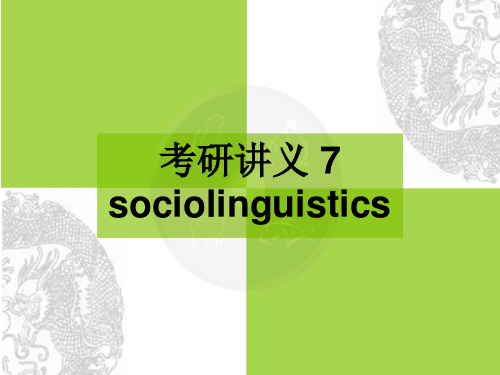
• Users of the same language in a sense all speak differently. What each of them chooses to use is in part determined by one’s social background.
– When we speak we cannot avoid giving our listeners clues about our origin and our background.
– 肥皂剧、卡通、布丁、苹果派、雀巢、巴士、 排挡、耐克、因特网、KTV、EMAIL – Typhoon, gongfu, etc.
15
Netspeak 网络语言
• • • • • • • • • • 顶(支持) 555(呜呜呜) ding(顶) mm/MM(妹妹) LZ(楼主) DD/dd(弟弟) 88(拜拜) 偶(我) 马甲(ID) ID • • • • • • • • • • 斑竹(版主) 恩(嗯) 汗或寒(敬畏) 晕(非常惊异) ps/PS(photoshop的简称) 灌水(发帖子) ddd(顶顶顶) bs/BS(鄙视) 楼猪(楼主) 滴(的、地) 16
9
• Sapir-Whorf Hypothesis
– Edward Sapir (1884 - 1939) and Benjamin Lee Whorf (1897-1941)
• Our language helps mould our way of thinking and, consequently, different languages may probably express speakers’ unique ways of understanding the world.
sociolinguistics (1)
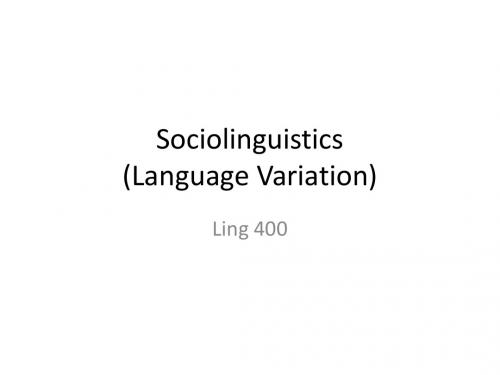
Case study (Japanese)
• There are some interesting socio-semantic facts that should be of interest to you. I will discuss some of them.
Sociolinguistics and Semantics
Pronouns and address terms Japanese has many first and second pronouns, but when they are used (esp. 2nd person pronouns), you have to be very careful. You usually avoid them. (It is hard not to be rude.) 1st: gender neutral: watakushi, watashi male: boku, ore, oira, washi (obsolete) female: atashi, uchi (Kyoto dialect?) 2nd: an(a)ta, omae, kimi, kisama, NAME-san, NAMEkun, NAME-tyan, kisama (archaic and rude) kisama ‘honorable person’ can only be used when you are ready to fight.
Sociolinguistics and Semantics
Pronouns and address terms 3rd: kare ‘he’, kanozyo ‘she’, ano-hito ‘that person’, ano-ko ‘that child’ ‘that girl’ kare ‘he’ and kanozyo ‘she’ were introduced only recently Name-san can be used in sentences (e.g. questions) addressed to this person. So it is indeed like a second person pronoun. E.g. Does Mr. Tanaka like sushi? This can mean ‘Mr. Tanaka, do you like sushi?’ in Japanese.
社会语言学名词
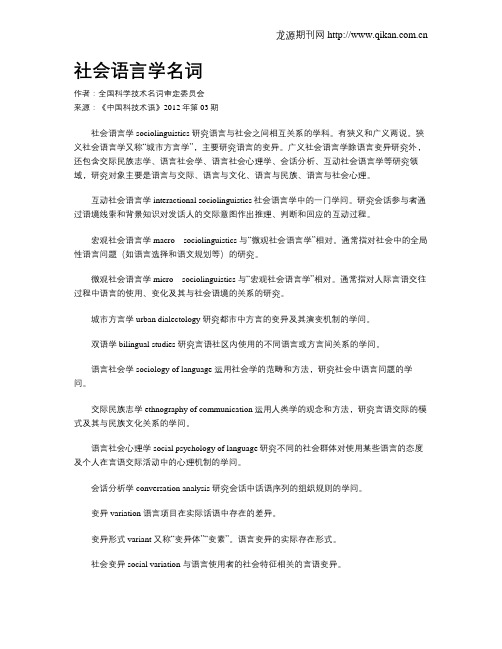
社会语言学名词作者:全国科学技术名词审定委员会来源:《中国科技术语》2012年第03期社会语言学 sociolinguistics 研究语言与社会之间相互关系的学科。
有狭义和广义两说。
狭义社会语言学又称“城市方言学”,主要研究语言的变异。
广义社会语言学除语言变异研究外,还包含交际民族志学、语言社会学、语言社会心理学、会话分析、互动社会语言学等研究领域,研究对象主要是语言与交际、语言与文化、语言与民族、语言与社会心理。
互动社会语言学 interactional sociolinguistics社会语言学中的一门学问。
研究会话参与者通过语境线索和背景知识对发话人的交际意图作出推理、判断和回应的互动过程。
宏观社会语言学 macro sociolinguistics 与“微观社会语言学”相对。
通常指对社会中的全局性语言问题(如语言选择和语文规划等)的研究。
微观社会语言学 micro sociolinguistics 与“宏观社会语言学”相对。
通常指对人际言语交往过程中语言的使用、变化及其与社会语境的关系的研究。
城市方言学 urban dialectology 研究都市中方言的变异及其演变机制的学问。
双语学 bilingual studies 研究言语社区内使用的不同语言或方言间关系的学问。
语言社会学 sociology of language 运用社会学的范畴和方法,研究社会中语言问题的学问。
交际民族志学 ethnography of communication运用人类学的观念和方法,研究言语交际的模式及其与民族文化关系的学问。
语言社会心理学 social psychology of language研究不同的社会群体对使用某些语言的态度及个人在言语交际活动中的心理机制的学问。
会话分析学 conversation analysis 研究会话中话语序列的组织规则的学问。
变异 variation 语言项目在实际话语中存在的差异。
社会语言学和语言社会学 英文解释

社会语言学和语言社会学英文解释
社会语言学(Sociolinguistics)是研究语言在社会中如何使用、变化和发
展的学科。
它关注语言与社会的相互关系,包括语言的变化、语言的多样性、语言的社会功能、语言与身份的关系等等。
社会语言学试图理解语言在社会生活中的作用,以及社会因素如何影响语言的使用和变化。
语言社会学(Sociology of Language)是研究语言在社会结构和社会变迁中的地位和作用的学科。
它关注语言的形成、变化和发展,以及语言如何影响社会的形成和发展。
语言社会学也研究语言在社会中的功能,以及语言如何反映和塑造社会结构和文化。
简而言之,社会语言学更关注语言在社会生活中的具体应用和变化,而语言社会学更关注语言在社会结构和文化中的作用和地位。
这两个学科有很多交叉点,但研究重点和方法有所不同。
- 1、下载文档前请自行甄别文档内容的完整性,平台不提供额外的编辑、内容补充、找答案等附加服务。
- 2、"仅部分预览"的文档,不可在线预览部分如存在完整性等问题,可反馈申请退款(可完整预览的文档不适用该条件!)。
- 3、如文档侵犯您的权益,请联系客服反馈,我们会尽快为您处理(人工客服工作时间:9:00-18:30)。
1.3 Regional variation 地區的差異
• Variation差異according to根據 the particular特定的 geographical地理的 area where a speaker comes from. • The most distinguishable可區別的,可辨別的 linguistic feature特徵,特色 of a regional dialect方言 is its accent口音,腔調 . • geography地理
• 例: pidgin English:文法構造簡化,字彙混 雜,含華語、葡語、馬來語的通商英語 (曾譯為洋涇濱英語)
Lingua franca VS. Pidgin
• Lingua franca may have native speakers such as English • Pidgin is not a native language of a particular region.
1.5 Stylistic variation 文體的差異
• There are intraspeaker說話者內部的 differences associated with與…相關 the speech situation情況 : who is speaking to whom about what under what circumstances情形 for what purpose目的.
• Black English You crazy. (You’re crazy.) That my bike. (That’s my bike.) The coffee cold. (The coffee’s cold.)
• Is it a Mr. Johnson in this office? (Is there a Mr. Johnson in this office?) • He don’t know nothing. (He doesn’t know anything.) • I ain’t afraid of no ghost. (I’m not afraid of any ghost.) • He don’t ever go nowhere. (He never goes anywhere.)
High variety
• One is a more standard variety called the high variety, which is used for more formal正式的 or serious重要的 matters事情, such as speeches made in government, the media, school, or church.
3. Diglossia高低雙語現象 and bilingualism雙語
• When people of a community speak two different regional or national dialects for different purposes, sociolinguistic situations情形 (known as diglossia and bilingualism) emerge 出現.
• E.g. Latin—18th century—European Beijing dialect– 56 dialects--Chinese
2.3 Pidgin併用兩種或多種 語言的混雜語;洋涇濱語
• A pidgin is a variety of language that is generally used by native speakers of other languages as a medium of communication. • A pidgin is used for some practical實用的 purpose目的 , such as trading, by a group of people who do not know each other’s languages.
• A regional dialect may gain status地 位 and become standardized標準化的 as the national or official官方的 language of a country, and spoken by most, if not all, ofespread分佈(或散佈)廣 的 and most familiar世所周知的;熟悉 的 ethnic variety變種 of the English language is Black English, spoken mostly by a large section部分 of nonmiddle-class American Blacks.
Chapter 8
Sociolinguistics 社會語言學
Sociolinguistics 社會語言學
• The study of language in social社會的 contexts情境
1. Language variation差異
• Language use varies不同 from one speech community社群 to another, from one regional地區的 group to another, from one social社會的 group to another, and even from one individual個人 to another.
1.4 Social variation 社會的差異
• People’s sociolects社會用語特徵 are defined定義 by linguistic differences that reflect反映 their socioeconomic 社會經濟的, educational教育的, occupational職業的 and ethnic種族的 background, as well as their sex and age groups.
2.1 The nature of standard 標準語 and nonstandard language非標準語
• The standard language標準語 is a superposed被放在上面, socially prestigious 有名望的 dialect of language. • It is the language employed使用 by the government政府 and the judiciary司法的 system, used by the mass media大眾傳播媒 體 , and taught in educational institution機 構.
5. Social dialect
• The speakers of a social dialect usually share a similar social background.
5.1 Education varieties 教育差異
1.1 Speech community 語言社群
• A group of people who form a community and share the same language or a particular variety of language.
1.2 Speech variety 語言差異
3.1 Diglossia高低雙語現象
• Two very different varieties不同 of language co-exist共存 in a speech community, each with a distinct明顯 的,清楚的 range範圍 of purely純粹地 social function功能 and appropriate適 當的 for certain某些 situations情況.
Low variety
• The other is a non-prestige名望,聲望, 威望 variety called the low variety, which is used in colloquial口語的 and other informal situations, such as conversations with family or friends, or instructions given to servants僕人, waiters, or workman.
• Speech variety refers to意指 any distinguishable可區別的,可辨別的 form of speech used by a speaker or group of speakers. • standard language, vernacular language方言 , dialect, pidgin
3.2 Bilingualism雙語
• Bilingualism refers to a linguistic situation in which two standard languages are used either by an individual個人 or by a group of speakers. • Canada is a typical example of official官方 的 bilingualism, where both French and English are recognized被承認 official languages.
1.6 Idiolectal variation 個人習語的差異
• No two speakers (of the same language or dialect) use their language or dialect (in exactly完全的 the same way).
